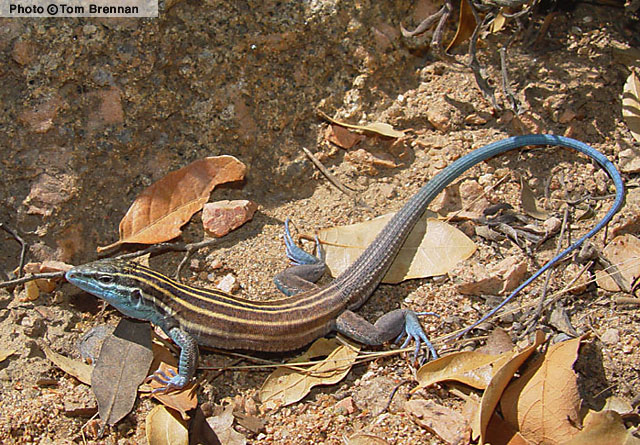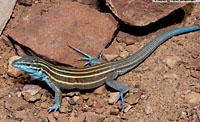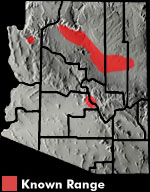Online Field Guide to The Reptiles and Amphibians of Arizona



Maricopa County, AZ
 Coconino Co., AZ |
| PAI STRIPED WHIPTAIL Aspidoscelis pai | |
|
DESCRIPTION: A small (up to 85 mm or 3.4″ from snout to vent) slim, brown to dark reddish-brown lizard with a long, thin, tail and a slim, pointed snout. The tail is bright blue and there are six light yellow stripes on the body. Some individuals have a very thin or incomplete seventh stripe down the middle of the back. The face, feet, and underside are tinted pale blue distinguishing this lizard from other whiptails in Arizona. It is further distinguished by its lack of spots on the body. The similar Arizona Striped Whiptail usually has seven stripes on the body instead of six. The body scales of the Pai Striped Whiptail are small and granular. The scales on the tail are large, keeled, and rectangular. The belly scales are large, smooth, and rectangular and the scales on top of the head are large, smooth, and plate-like. HABITAT: Primarily an inhabitant of Plains and Great Basin Grassland communities but also extends into Great Basin Conifer Woodland, Interior Chaparral, and Petran Montane Conifer Forest in some areas. BEHAVIOR: This is an active, diurnal, ground-dwelling lizard. It is frequently seen foraging or basking in the mid-morning sun. It hibernates during the cold months of winter and late fall. DIET: This lizard actively forages by rooting around in organic matter under bushes, clawing bark, and digging around the bases of logs, rocks, and other surface debris. It feeds on a variety of insects, spiders, centipedes, and small lizards. REPRODUCTION: Mates in spring and lays one or two clutches of eggs in spring or summer. Clutch size ranges from 1 to 3 eggs. By Thomas C. Brennan Brennan, T. C., & A. T. Holycross. 2006. A Field Guide to Amphibians and Reptiles in Arizona. Arizona Game and Fish Department. Phoenix, AZ Brennan, T. C., & A. T. Holycross. 2005. A Field Guide to Amphibians and Reptiles of Maricopa County. Arizona Game and Fish Department. Phoenix, AZ |
 |
Visit Partners in Amphibian and Reptile Conservation:


HOME
Copyright © 2023, Arizona Game and Fish Department. All rights reserved.
If you make use of the textual contents of this site in reports, publications, etc. please cite and credit the author(s) and photographer(s). All photos on this website are copyrighted. However, those found in the species account section may be used for any noncommercial scientific, educational, or conservation purposes provided that photographs are not altered and continue to bear the copyright symbol and name of the photographer. Please contact the photographer regarding commercial use of copyrighted photographs.









